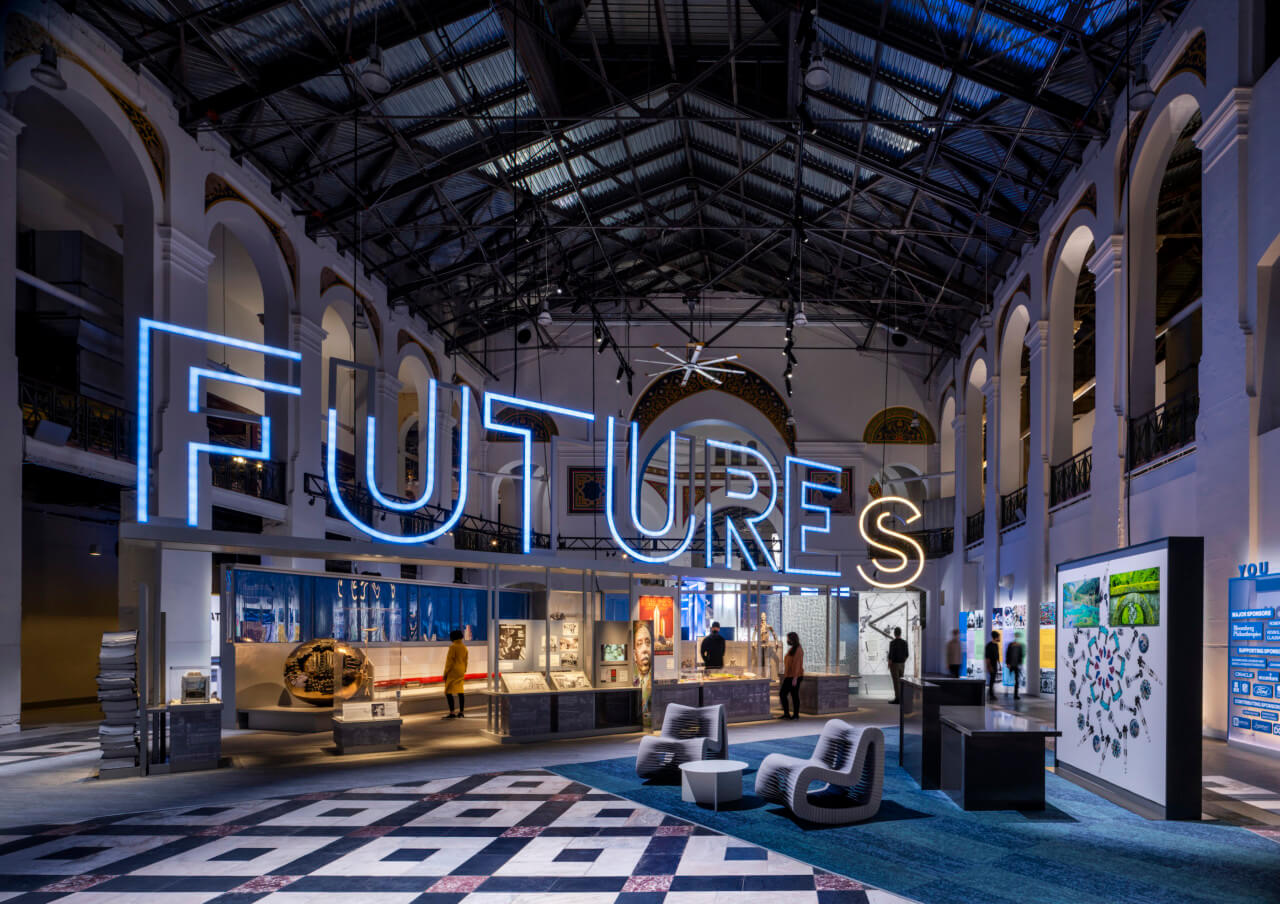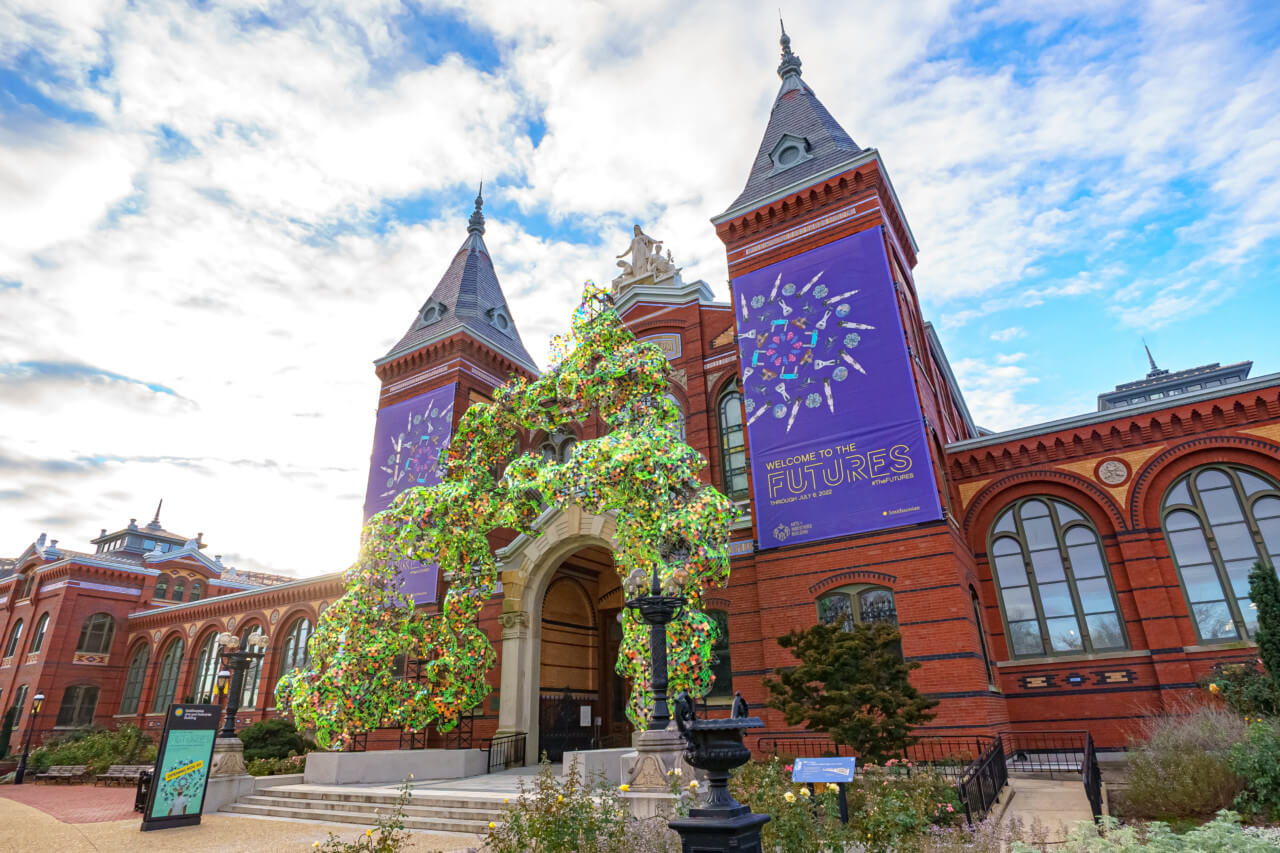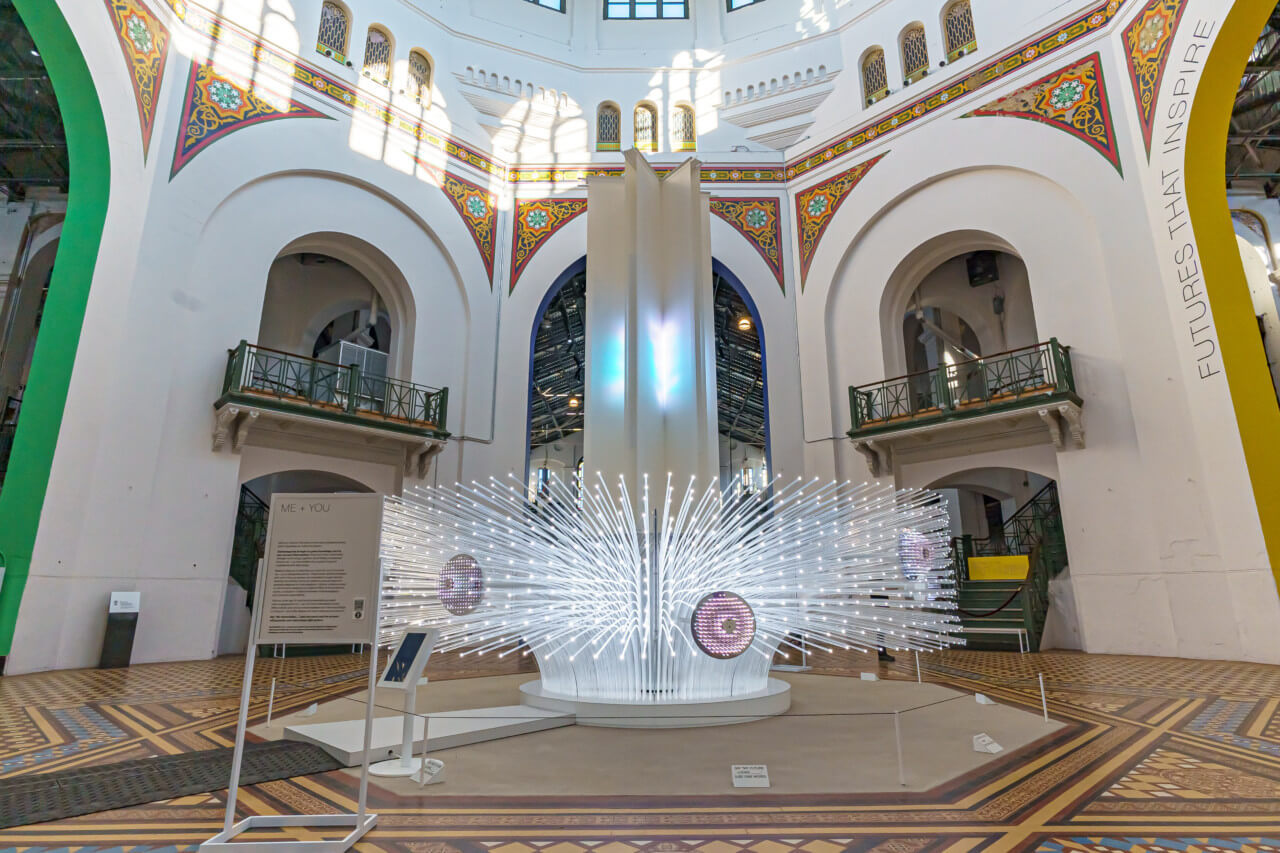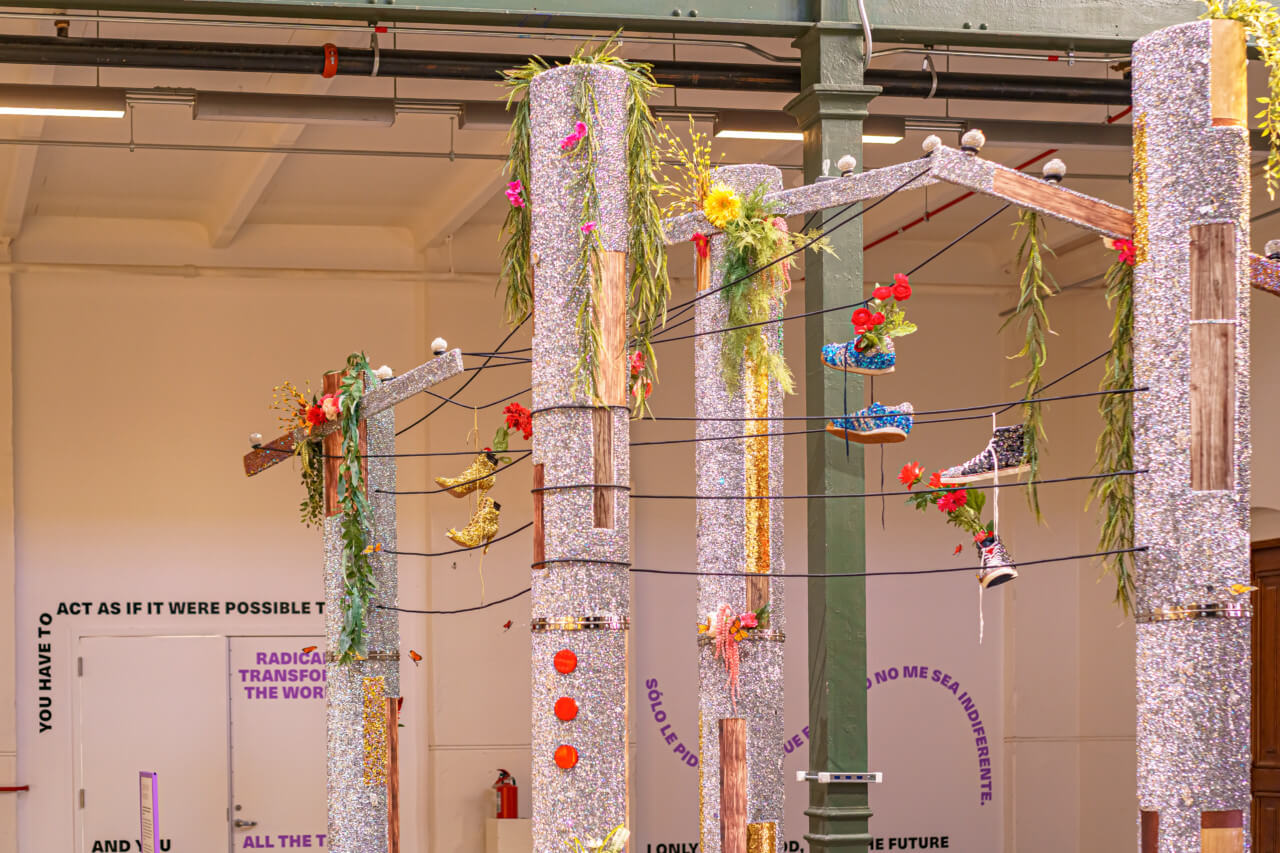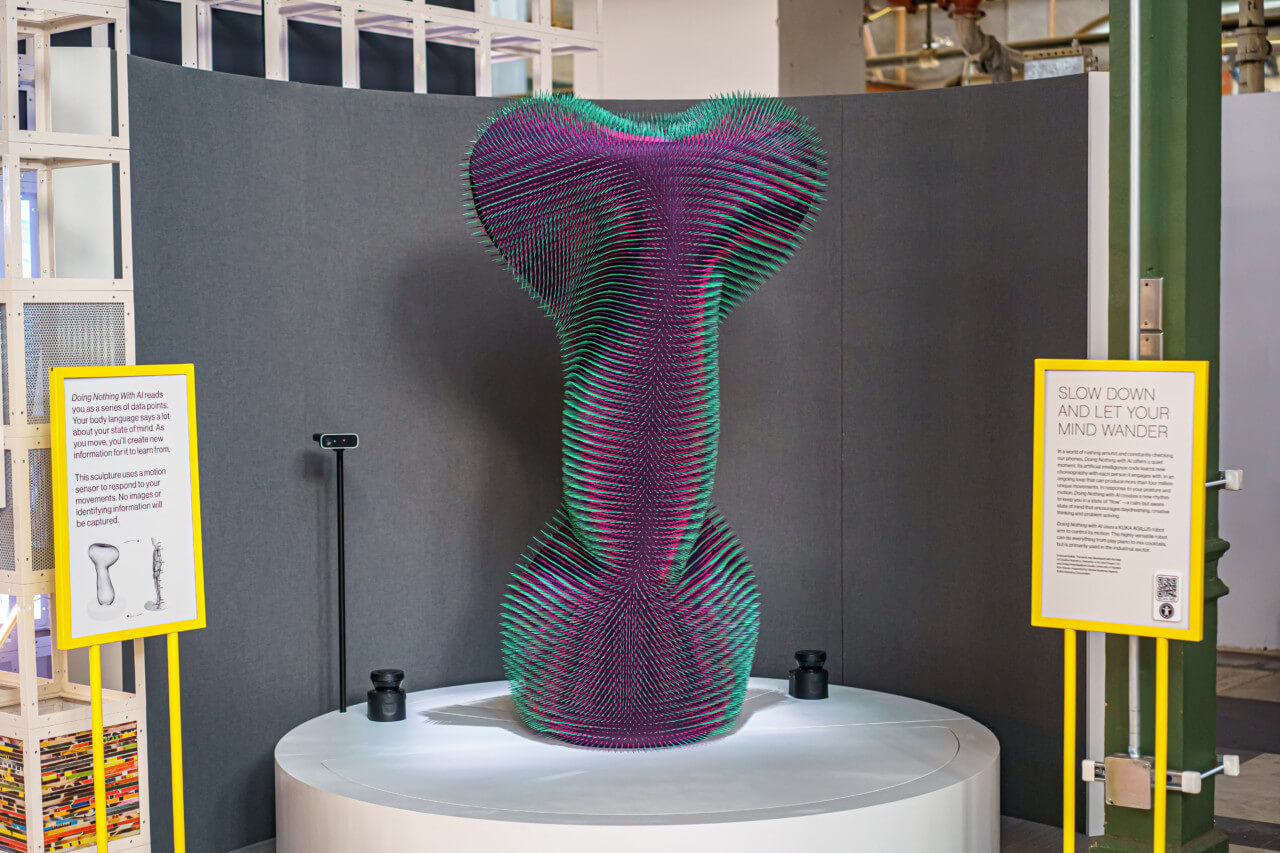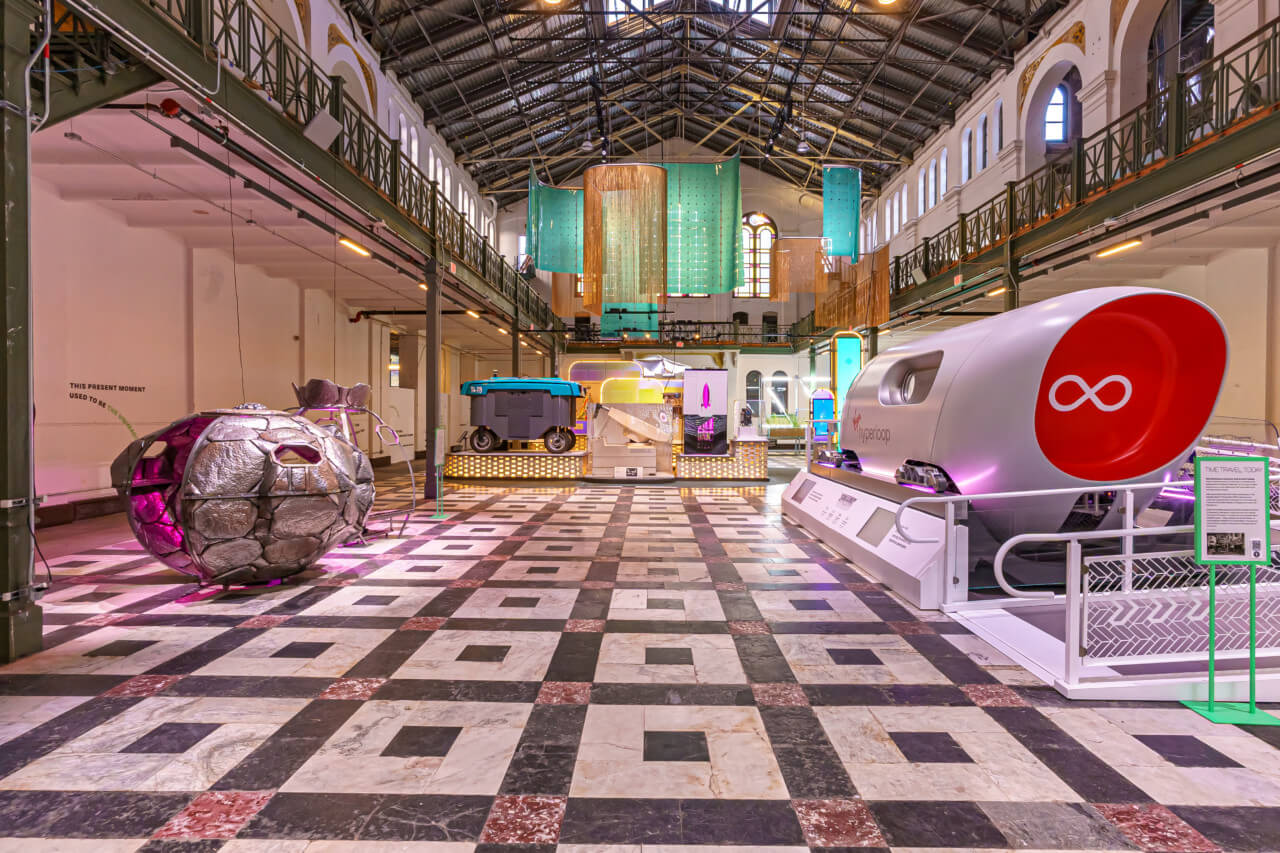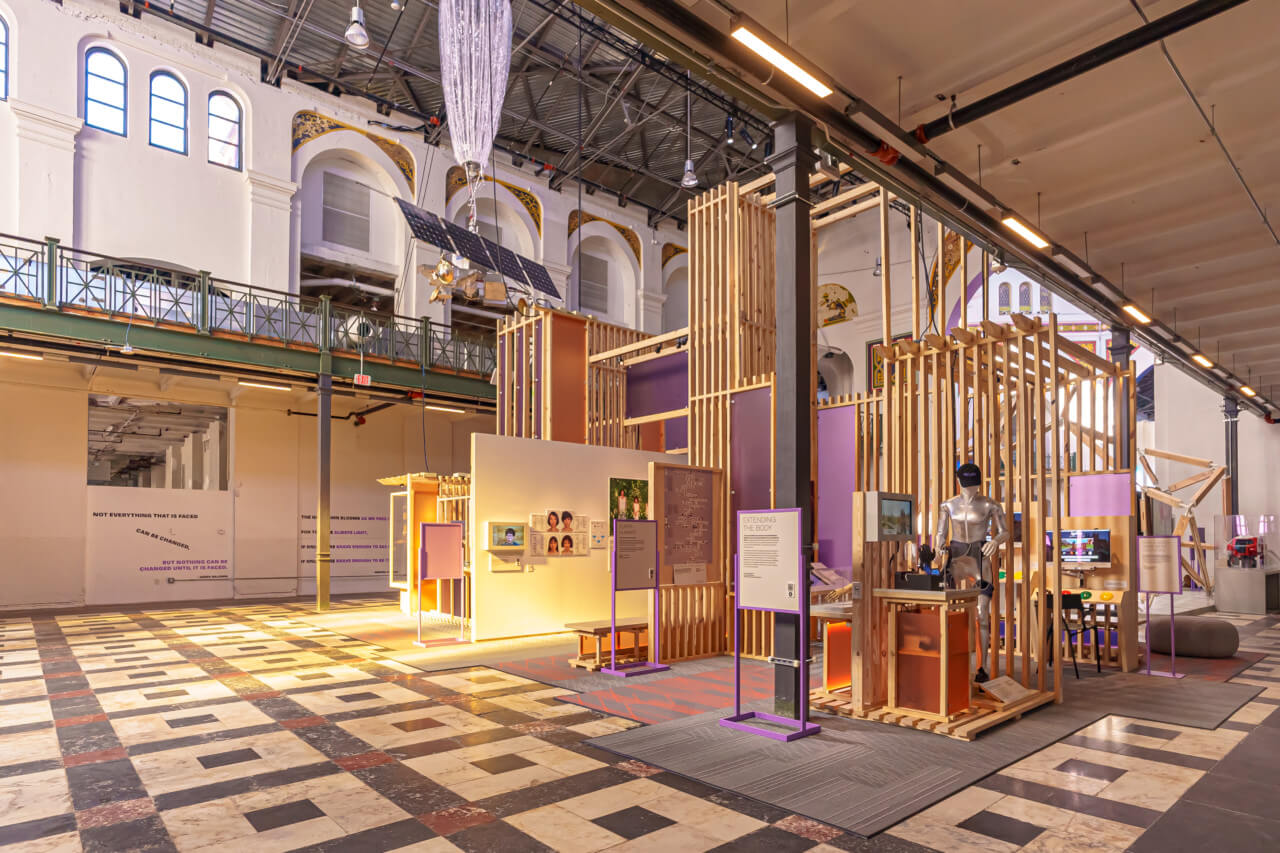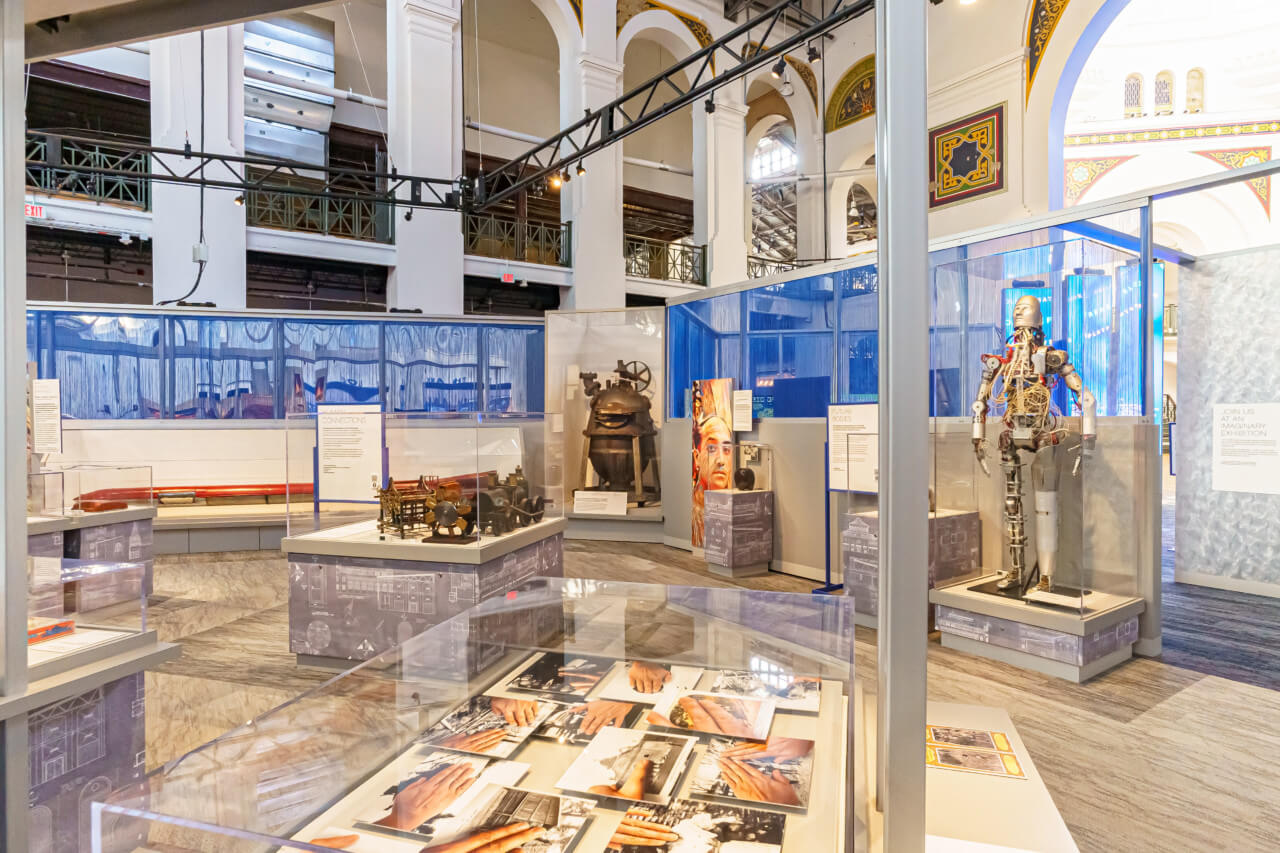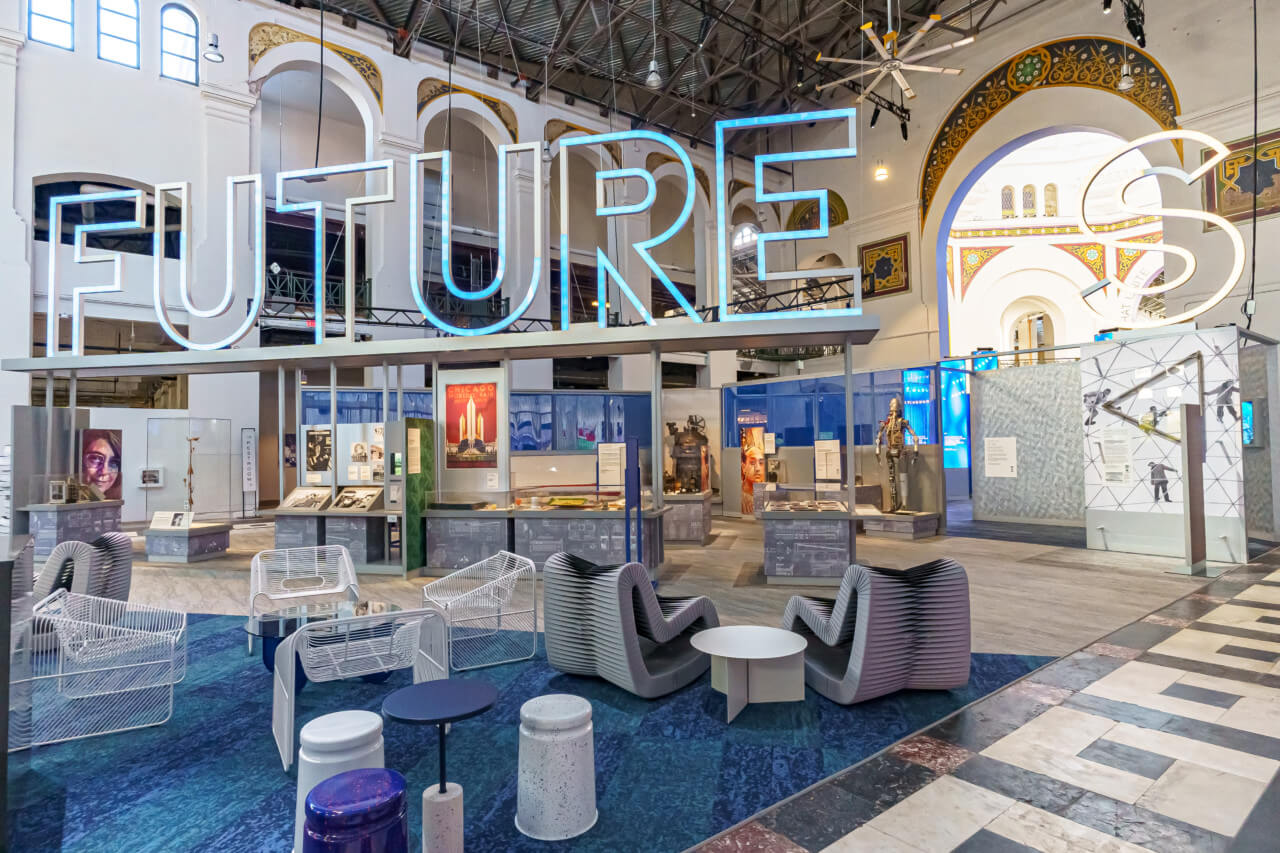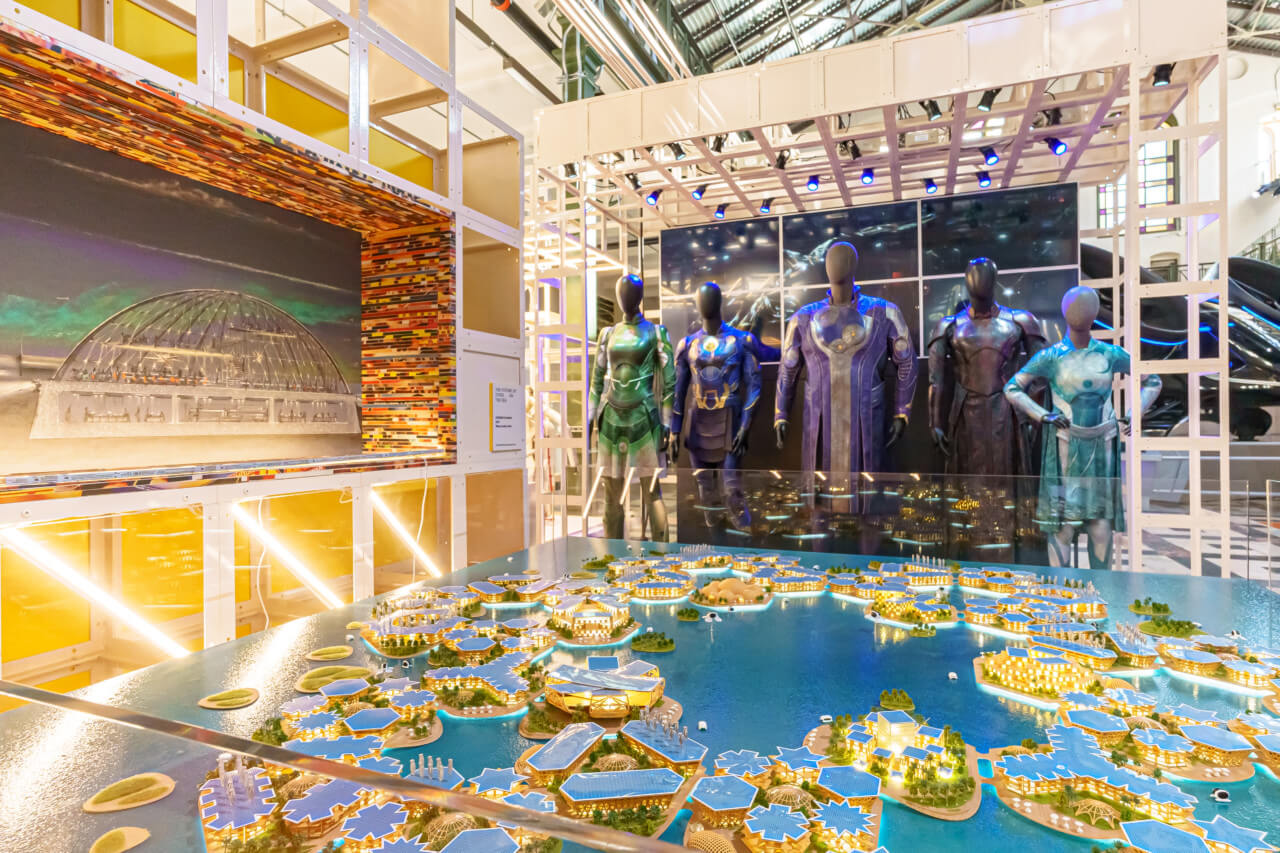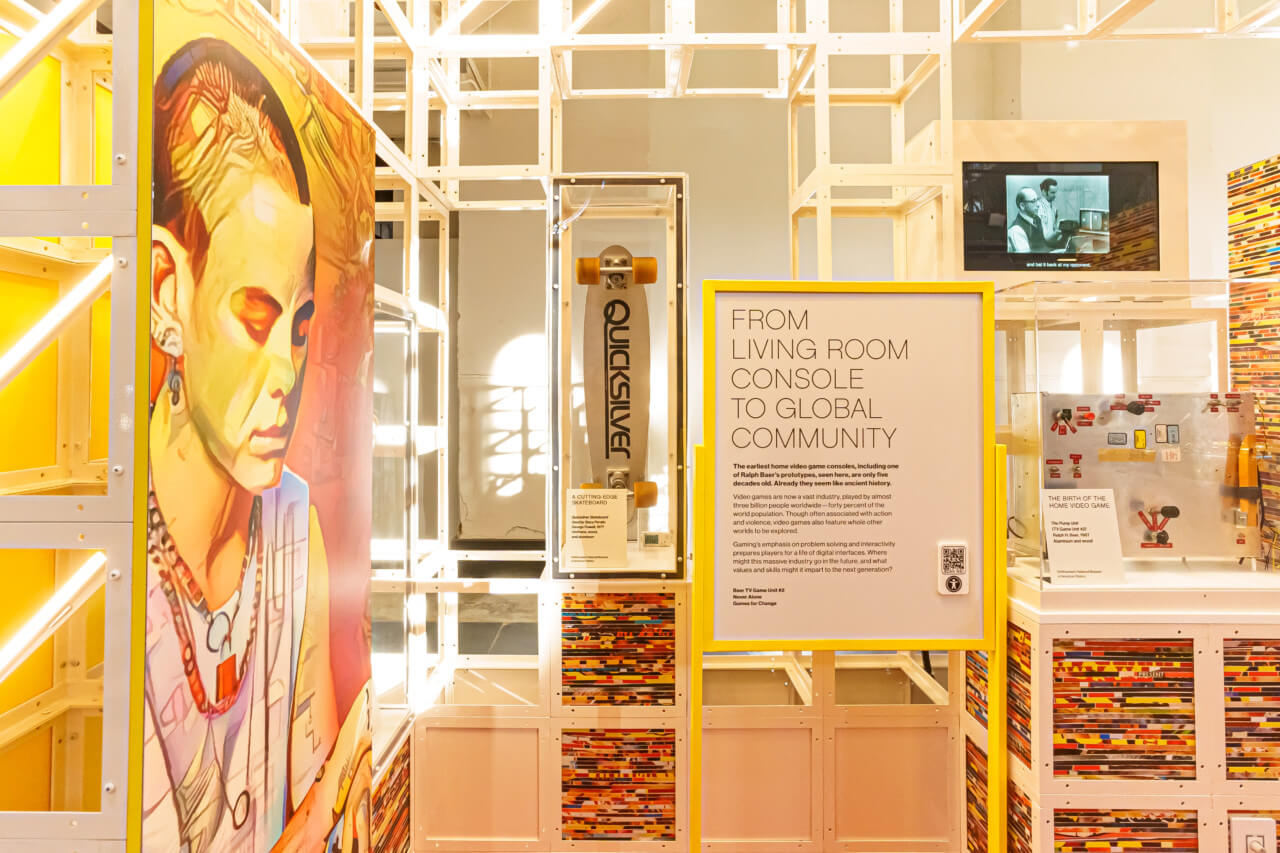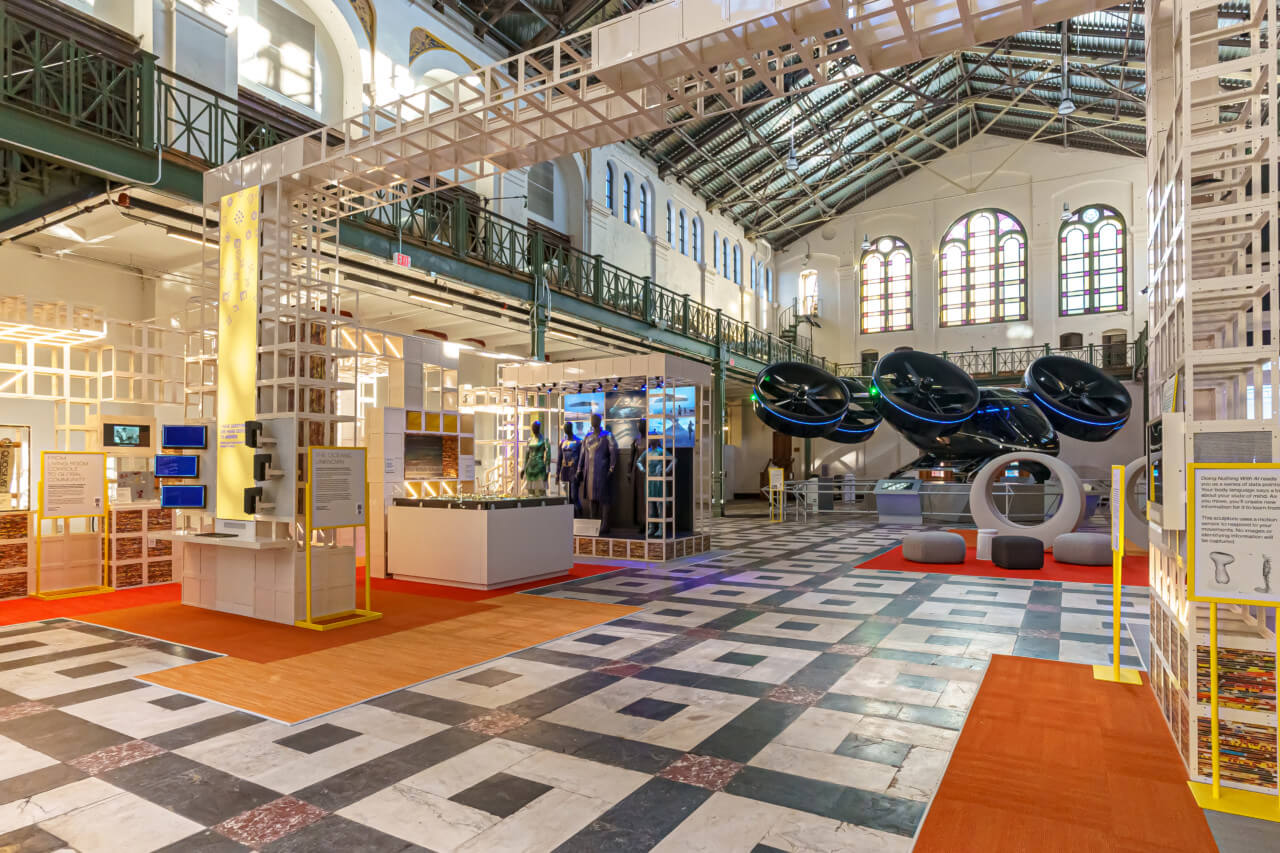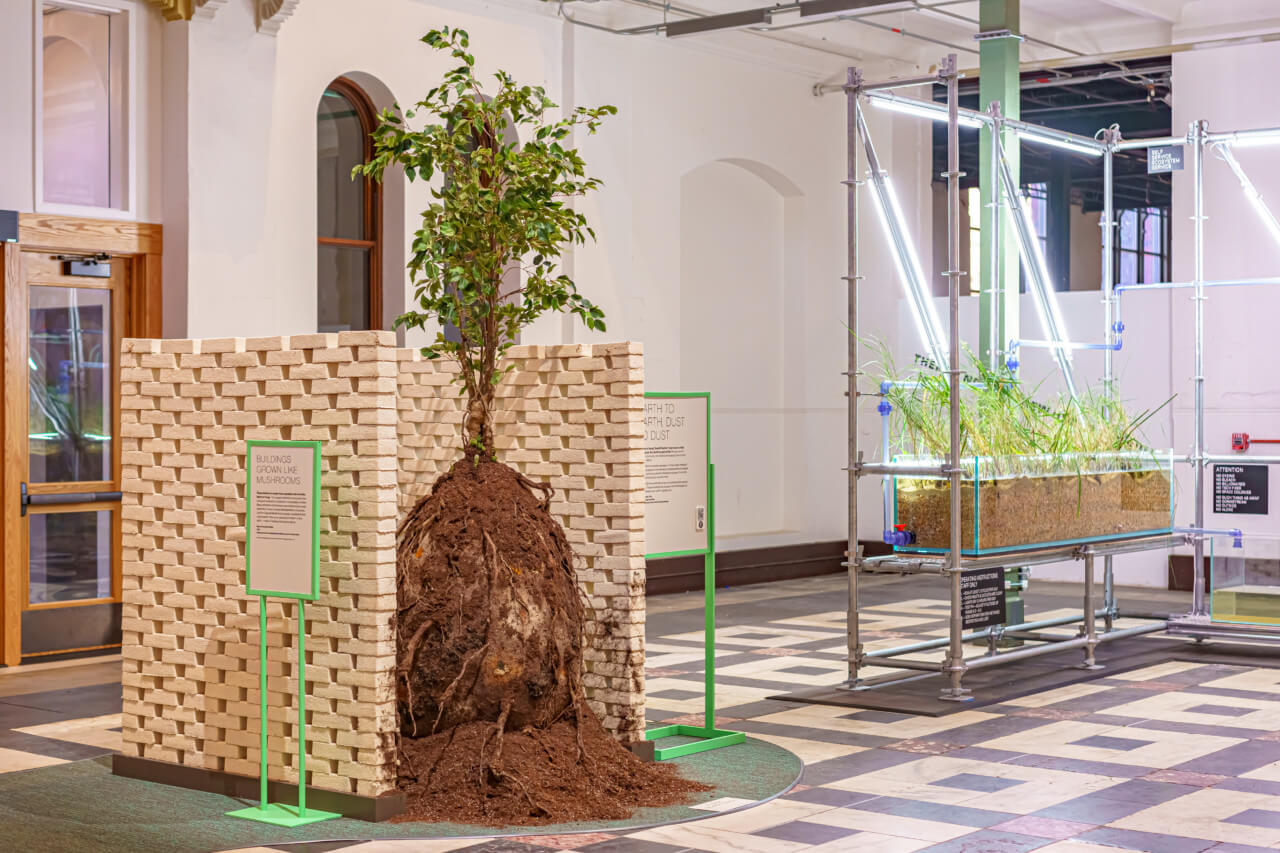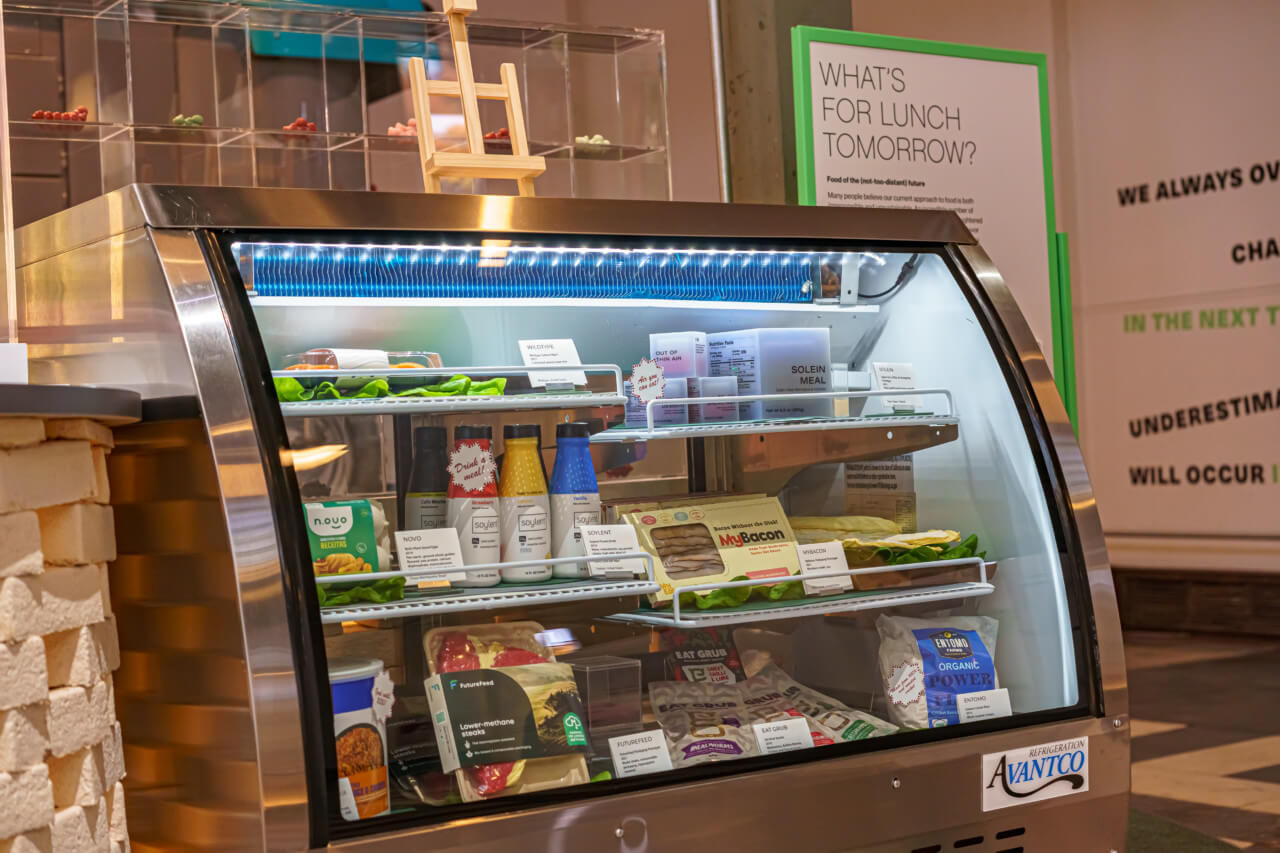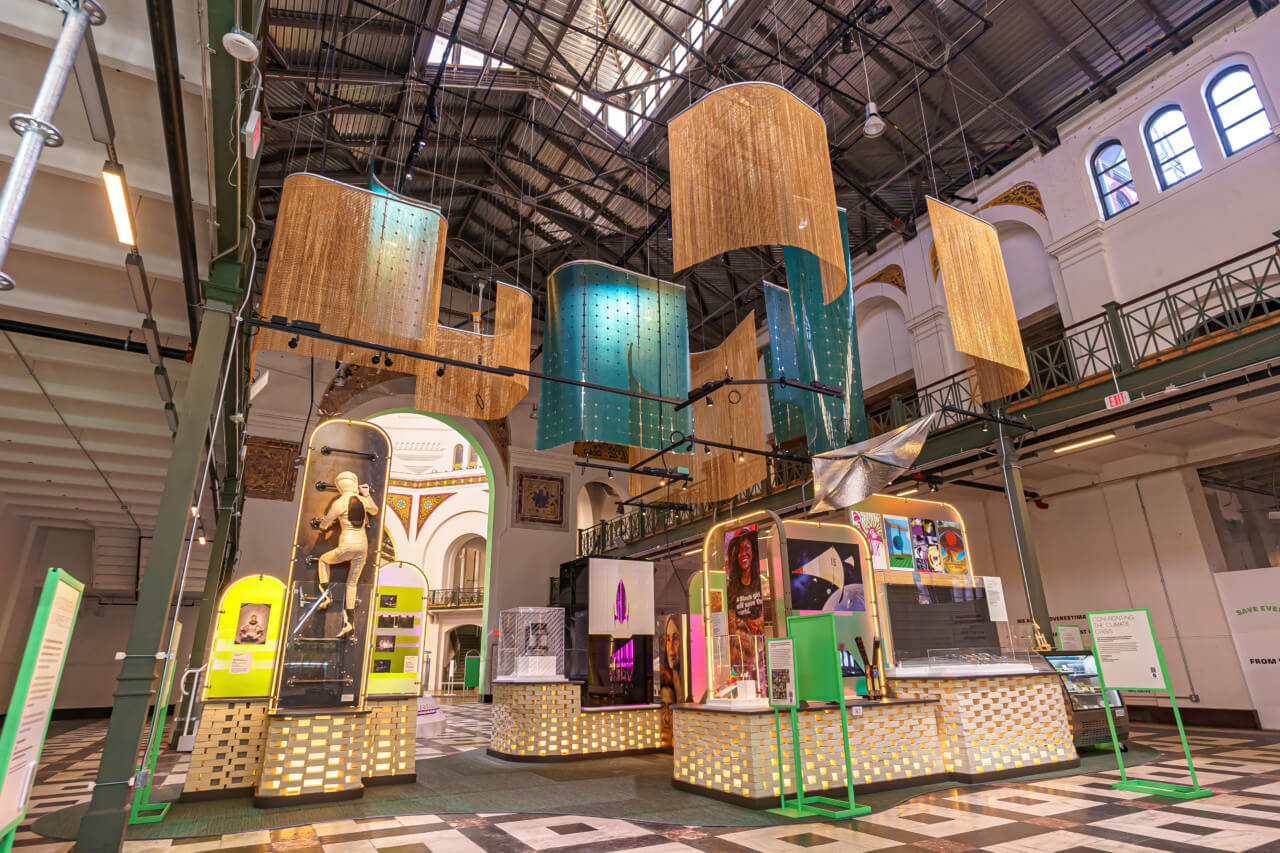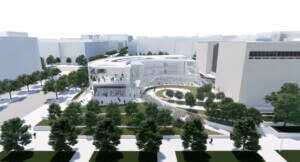What do a cloned ferret, a Bakelite baby monitor, biodegradable burial pods, genderless voice assistants, a century-old artificial limb, and a deli case stuffed with fake meat all have in common? They’re all among the dizzying assemblage of innovations past and speculative designs imagining a cleaner, greener, and more inclusive tomorrow showcased at the new Smithsonian exhibition, FUTURES.
A starry-eyed spectacle of big ideas, bold visions, and artificial intelligence-enabled contraptions and contrivances, FUTURES opens tomorrow, November 20, at the long-shuttered Smithsonian Arts + Industries Building (AIB) in Washington, D.C.
Coinciding with the 175th anniversary of the Smithsonian Institution, the three-years-in-the-making FUTURES is described as “one part exhibition, one part festival” that invites visitors to “dream big and imagine not just one but many possible futures on the horizon.” But the 35,000-square-foot exhibition designed by Rockwell Group really functions as a welcome back party for the grand old AIB. Debuting in 1881 as the host venue of the inaugural ball of four-month President James Garfield, this Renaissance Revival landmark on the National Mall known as the “Mother Museum” and “Palace of Wonders” has historically served as an ongoing, single-site World’s Fair where the seemingly impossible technologies of the day—Edison light bulbs, telephones, Apollo rockets, and the like—were presented to the American public for the first time.
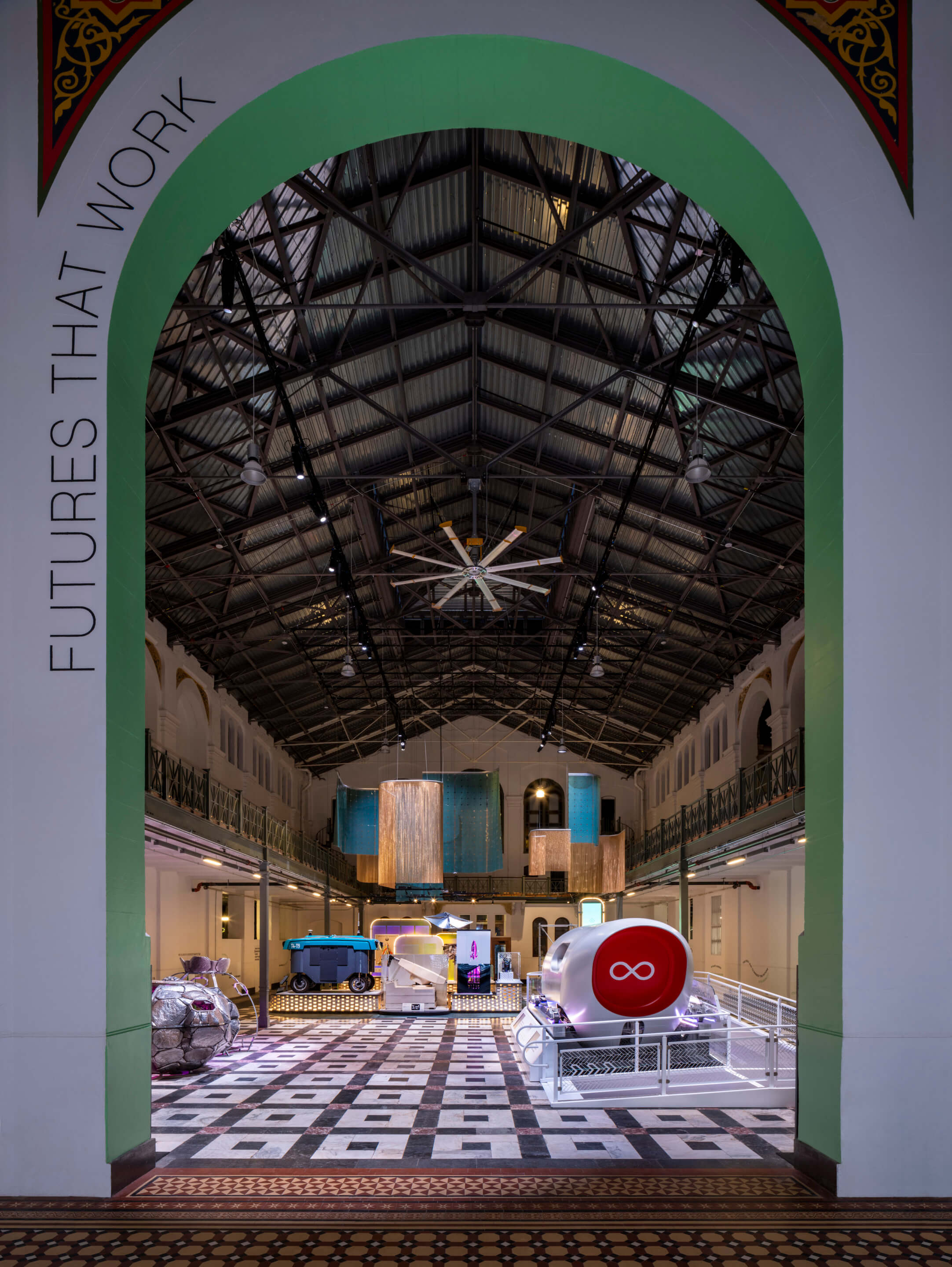
The AIB’s early World’s Fair-esque qualities were very much by design. Designed by Adolf Cluss and Paul Schultze, the sprawling building, comprised of four pavilions extending from a soaring central rotunda, was funded by proceeds from the 1876 Philadelphia Centennial Exposition.
Known as the National Museum up until 1910 when the National Natural History Museum opened its doors, the AIB, in the role of “origin and incubator for almost every other Smithsonian museum,” gradually began parting with its crowd-drawing marvels when its collections were rehomed at sister museums established throughout the 20th century including the National Air Museum (now the National Air and Space Museum) in 1946 and the Museum of History and Technology (now the National Museum of American History) in 1964. The nearly 100,000-square-foot building was eventually converted into office and storage space for the Smithsonian; having fallen into a state of disrepair over the decades, the AIB was closed off entirely to the public in 2004 due to structural concerns. The future of a museum famed for showcasing the most radical and forward-thinking examples of American ingenuity was very much unknown.
For FUTURES, many of the AIB’s treasures have temporarily returned home to the museum, which has been revived and is now open once again following crucial architectural stabilization work, infrastructural upgrades, and some cosmetic touch-ups carried out in recent years. A full top-to-bottom renovation has yet to come for the building, which was designated as a National Historic Landmark in 1971.
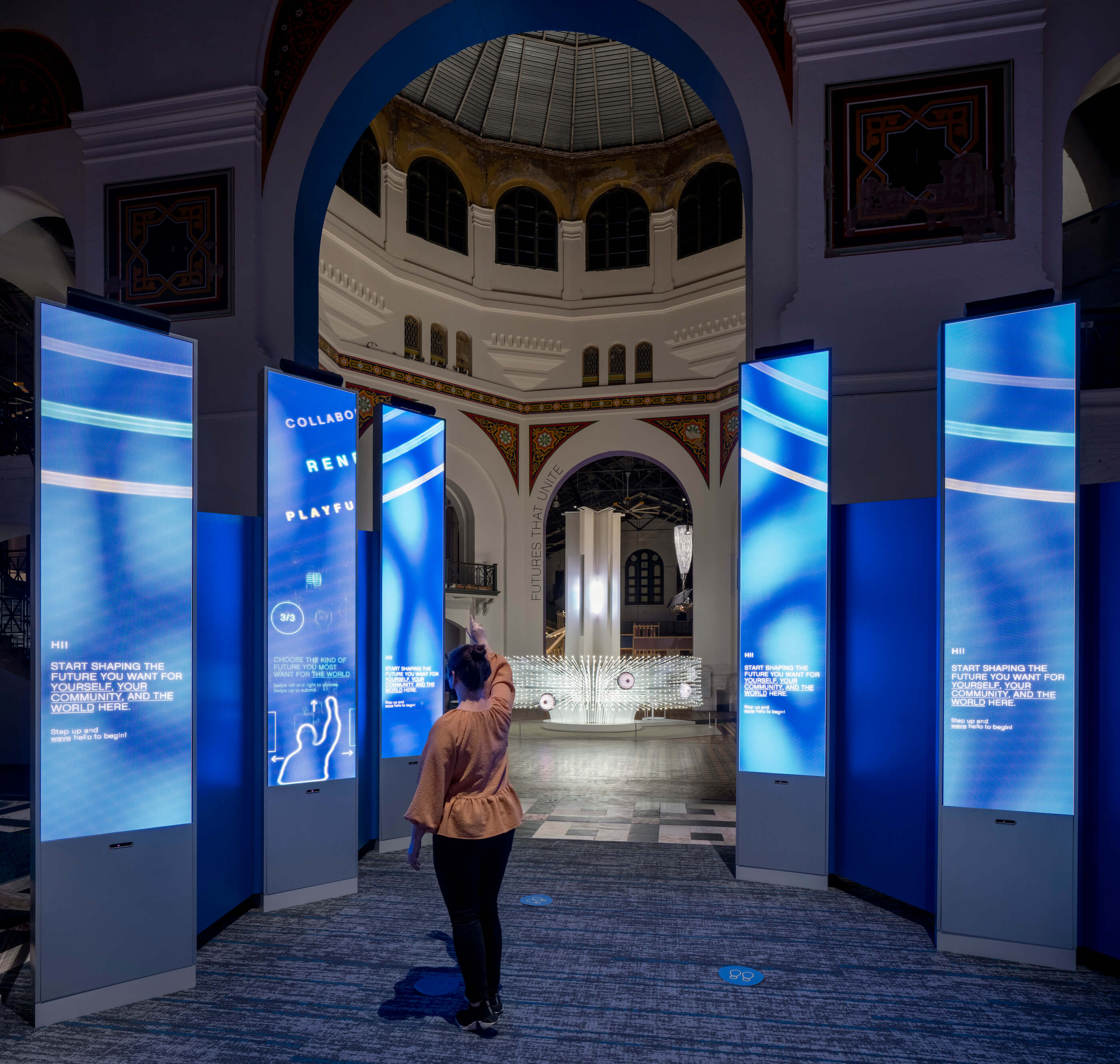
(FUTURES isn’t the very first time that it has been opened to the public since stabilization work was completed. A smattering of one-off events have been held in the building in recent years although FUTURES marks the first major exhibition at the AIB in almost 20 years and the very first full-on exploration of the future held on the National Mall.)
“I feel like we could do a flea market in this building and people would come because they’re so hungry to get inside of it,” said Rachel Goslins, Smithsonian director of the AIB. “[Many people] have been walking past it for decades now, and it has this air of mystery, history, and the unknown.”
The objects and artifacts pulled from the Smithsonian’s network of 23 museums and research centers are on display within Futures Past, one of four exhibition zones staged within each of the building’s monumental halls for FUTURES. Located in the North Hall, Futures Past serves as prelude of sorts to the larger exhibition where visitors can explore “innovations and provocative ideas of previous generations” including a Tellatouch Braille Writer, a piece of North America’s first geodesic dome, and a spacesuit testing android alongside, naturally, a trove of World’s Fair souvenirs. Portraits of “Featured Futurists” behind trailblazing ideas of both yesterday and today—Buckminster Fuller, Alexander Graham Bell, Isamu Noguchi, Helen Keller, and Octavia Butler among them—featured in FUTURES can be found throughout Futures Past and the three other exhibition areas. The portraits, 11 in total, were created by digital artist and educator Nettrice Gaskins using Deep Dream, an AI-enabled computer vision program from Google.
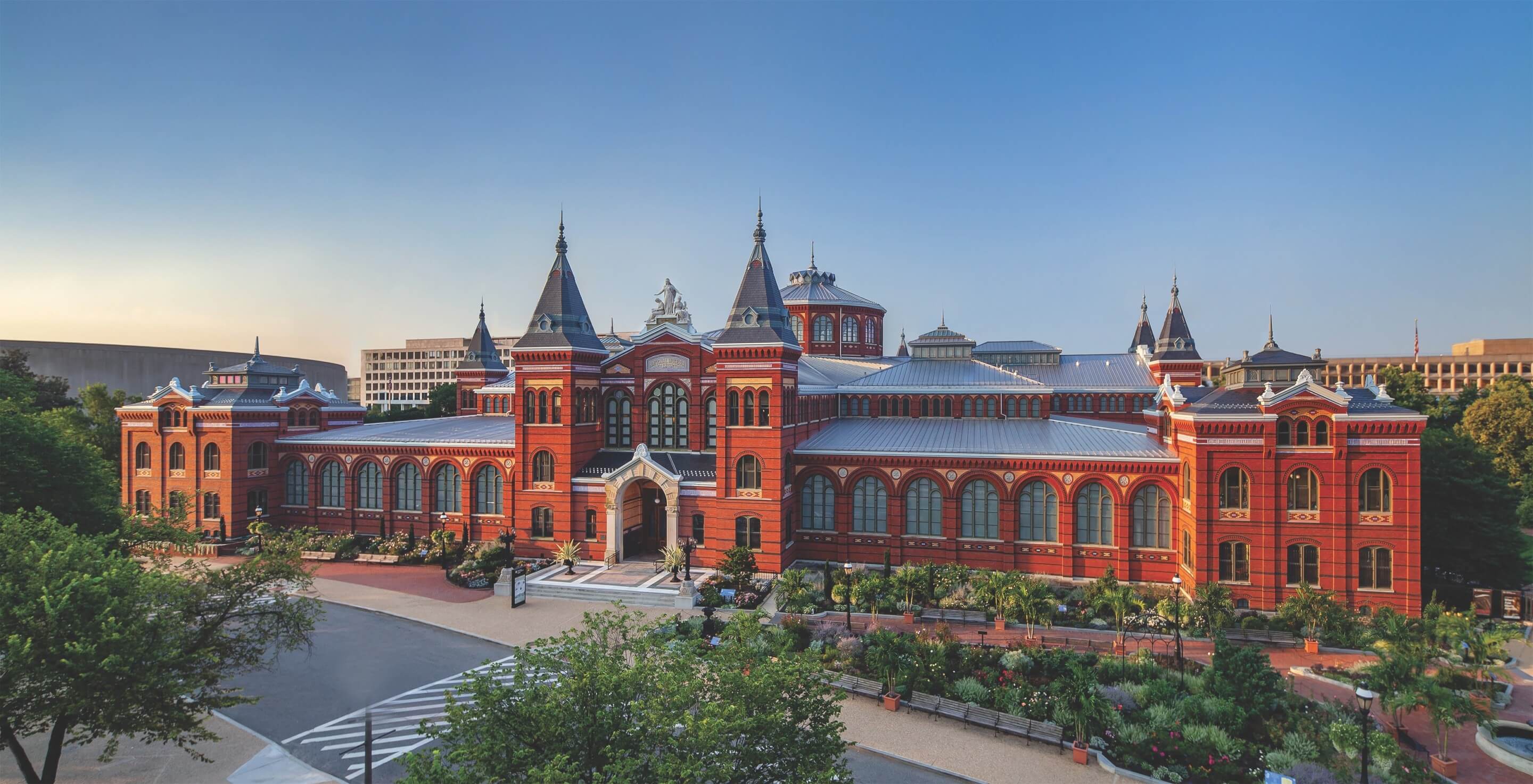
Moving through Futures Past, visitors move into the 90-foot-tall rotunda of the AIB and come face-to-face with the exhibition’s centerpiece interactive art commission, me + you by architect and artist Suchi Reddy of Manhattan-based studio Reddymade. A two-story work commissioned by Amazon Web Services that functions as a light sculpture and AI-powered repository of collective future visions, you + me, which also be accessed digitally via a parallel web app, invites visitors to gaze into it a la a monumental crystal ball while verbalizing their own dreams and wishes for the future into designated points within the installation’s shimmering sculptural cloud base. Harnessing a user’s tone, meaning, and sentiment, these spoken words are then translated into a unique kinetic mandala of color and light that then float upwards into a constantly evolving central totem, reflecting the work’s “digital artifact of collective futures.”
(This writer optimistically wished for a “relaxed” future, which generated a twinkling mandala of soothing light blue and green hues.)
“Really, the piece is about individual agency and collective responsibility,” said Reddy. “If I ask you to give me one word for your future, people stop to think. And for me, that’s the work. I really want people to be self-aware because I think [the] key to any of this conversation is really how we go into it, and what kind of outcomes that we’re looking for.”
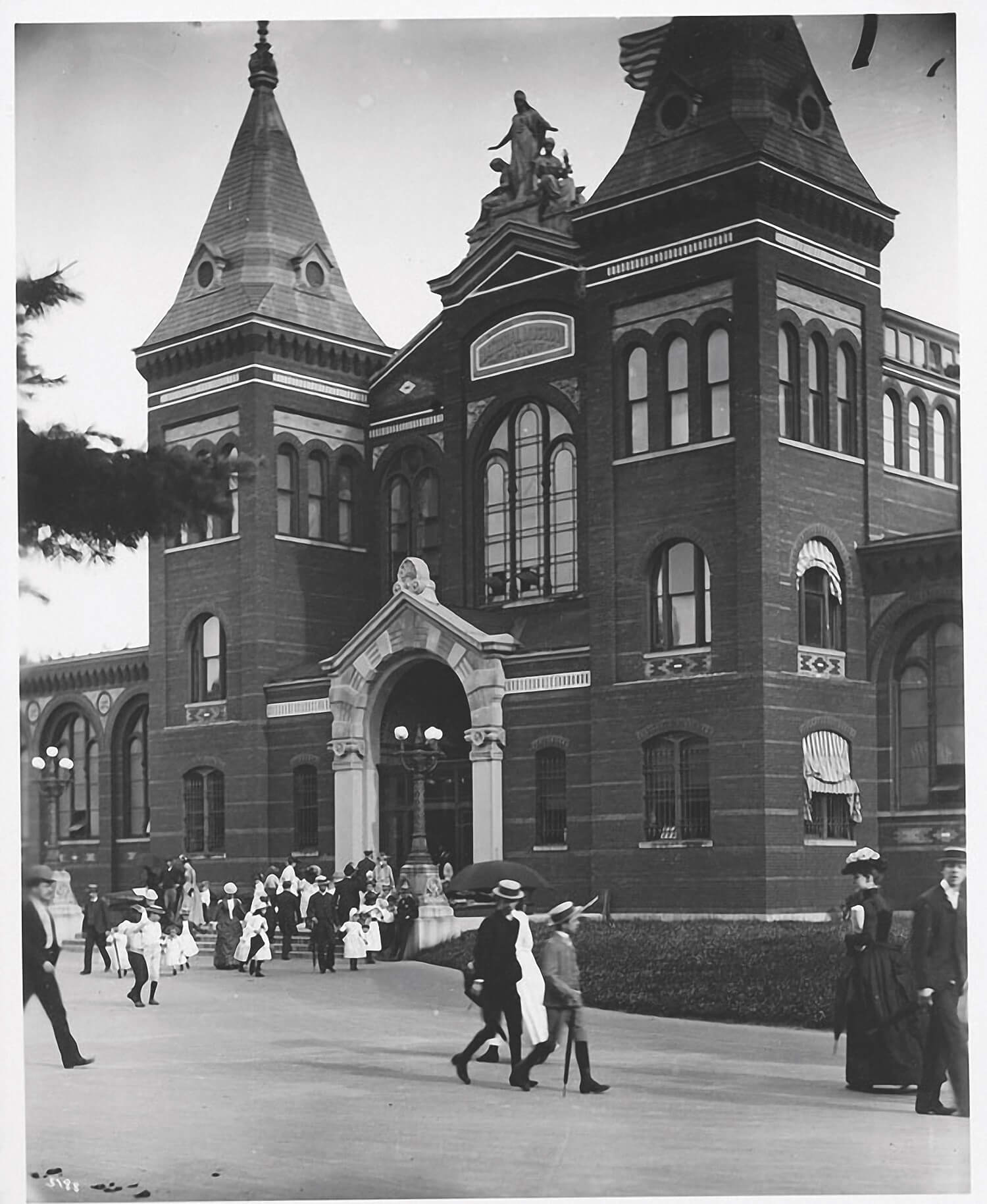
Fanning out in each direction from me + you are FUTURES’ three remaining thematic exhibition zones: Futures That Inspire, Futures That Work, and Futures That Unite located within the AIB’s East, West, and South Halls, respectively. Organized by the curatorial team of Ashley Molese (AIB curator), Brad MacDonald (creative media curator), Glenn Adamson (consulting curator), and Monica O. Montgomery (social justice, special projects, and program curator) in collaboration with Rockwell Group, Goslins, and an expansive list of artists, designers, and makers, FUTURES is brimming with interactive installations, speculative design concepts, and commissioned artworks that, when considered together, look to the future with unbridled optimism without coming across as overly quixotic or naïve. The curatorial approach never falls back on predictions—an easy trap when organizing an exhibition on “the future”—and instead emphasizes possibilities, which based on the scope and scale of FUTURES, are diverse as they are limitless.
That said, this isn’t Disney’s Tomorrowland and the exhibition focuses largely on concepts that tackle real-world issues ranging from climate change to food insecurity to racial injustice to feelings of isolation and loneliness brought on by the pandemic (apparently, there’s a robotic roommate for that).
In addition to both influencing and financing the AIB itself, World’s Fairs of yore also played into the thinking behind FUTURES.
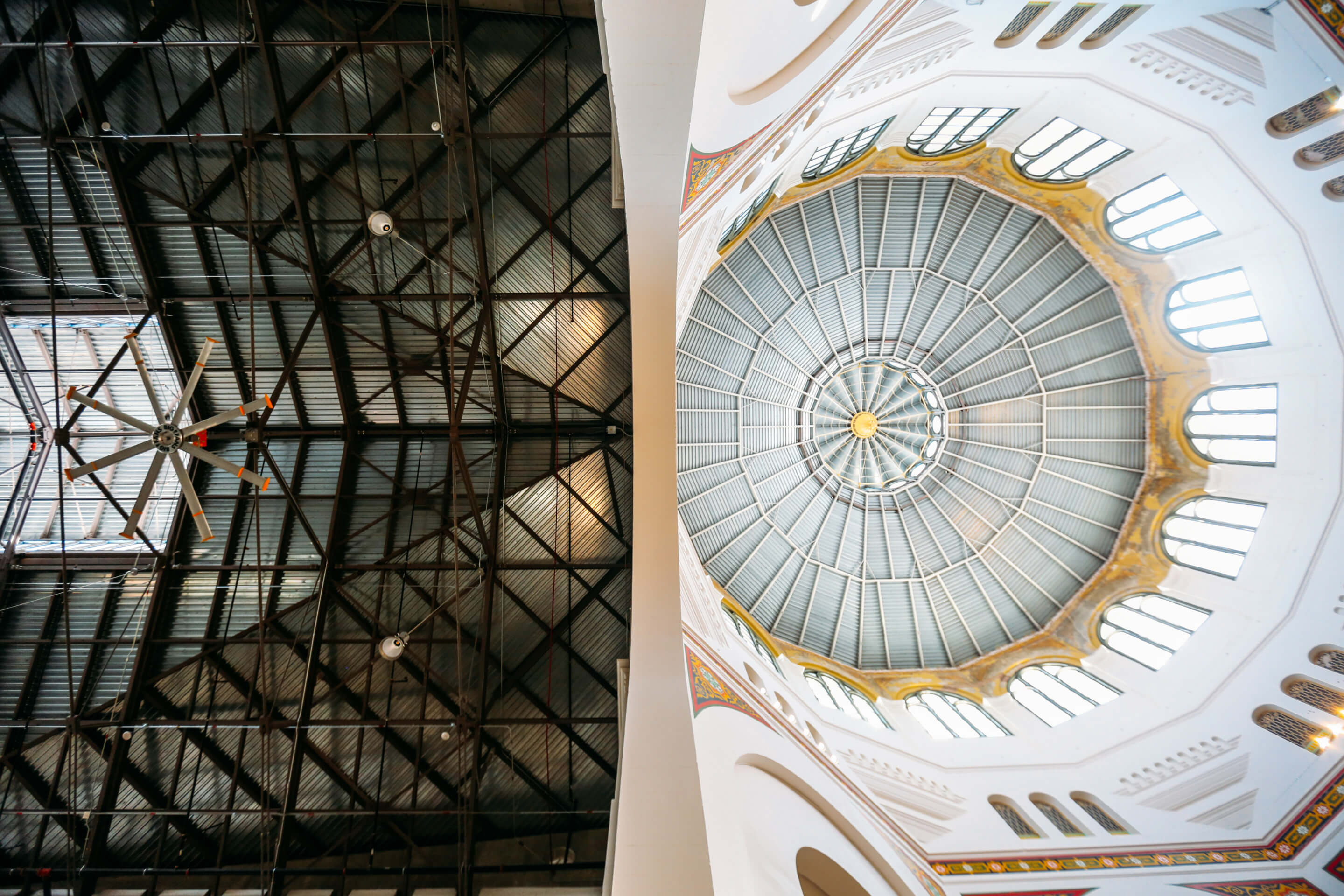
“They [World’s Fairs] are definitely a North Star for us both in terms of leaning into and also reacting to this sort of sense of magic, discovery, and possibility,” explained Goslins. “But they were also somewhat unremitting in their techno-optimism, and they also left a lot of people out. Trying to do the contemporary version of the World’s Fair is something that has been in our conversations.”
Of course, FUTURES also includes full-scale examples of ideas that, not long ago, were wholly dismissed as (sometimes literal) flights of fancy like self-driving flying taxis (the Bell Nexus) and high-speed travel via vacuum tube (Virgin Hyperloop’s Pegasus pilot pod). But perhaps most effective are the elements of the exhibition firmly rooted in our present-day reality, such as Devan Shimoyama’s large-scale work, The Grove, which implores visitors to pause and reflect on the unprecedented societal struggles that emerged last year in the form of racial violence and a once-in-a-century global health crisis. Envisioned by Shimoyama as a “future monument to the present,” this rhinestone-bedazzled, silk flower-clad installation is both mournful and meditative and provides a potent counter to some of the loftier emerging technologies presented within the exhibition.
“The future is not all about blaring, loud screens screaming for your attention,” said David Rockwell, founder and president of the New York-headquartered interdisciplinary architecture and design firm Rockwell Group. “I think it’s the kind of exhibition that requires spending a little bit more time in and finding some unexpected things and maybe coming out with a different perspective than when you went in.”
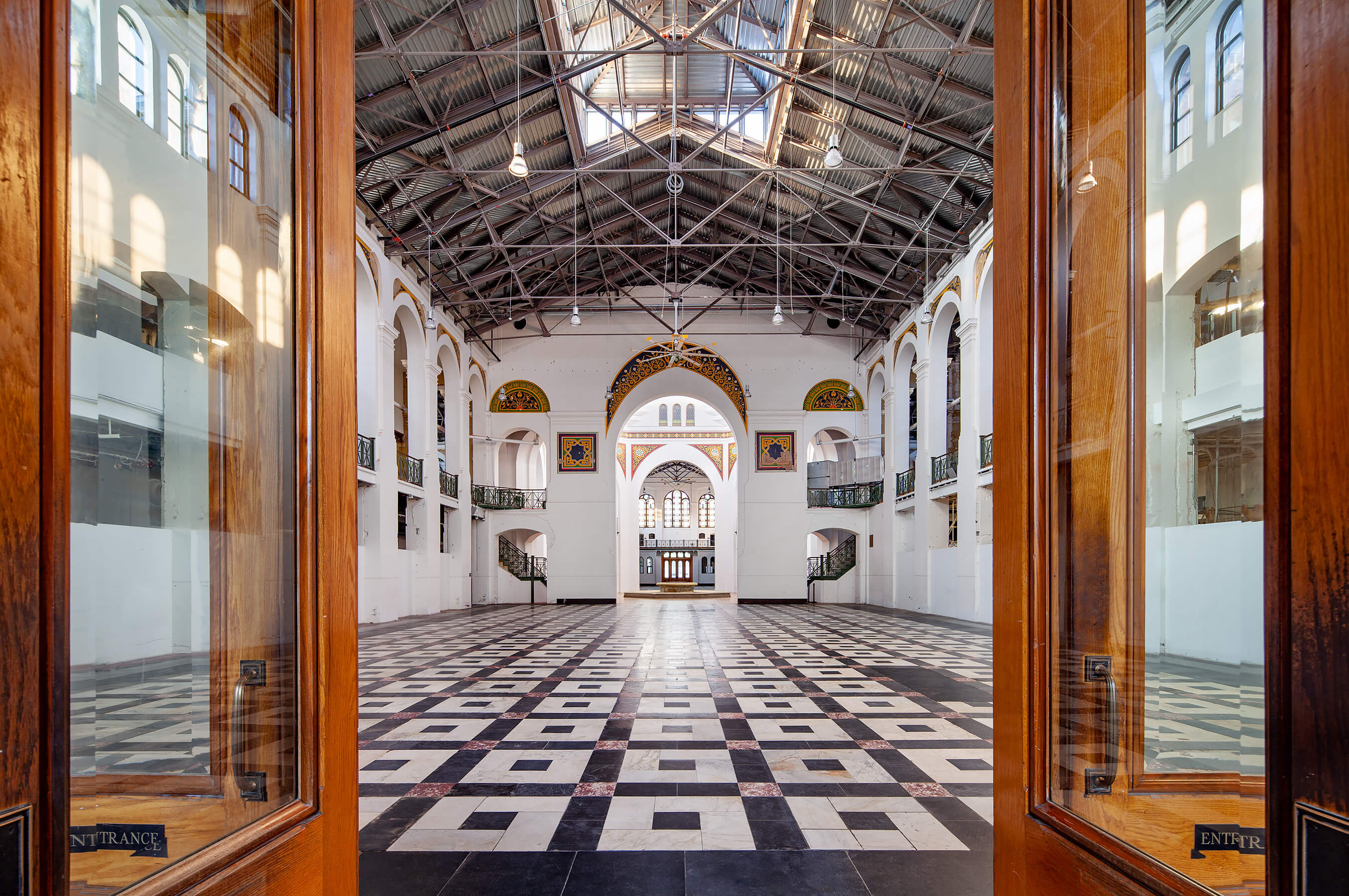
Celebrated for its theatrical set design work and award-winning hospital projects, Rockwell Group’s exhibition design employs a relatively light touch throughout due in part to the constraints of working within a 130-year-old landmarked building. A range of emerging building materials, including mycelium bricks, are used throughout without detracting from the historic character of the AIB. Rockwell Group took full advantage of this beguiling juxtaposition, one between FUTURES itself—an exhibition populated by flying taxis, vintage androids, and AI everything—and the raw, exposed nature of a historic structure undergoing a metamorphosis. If FUTURES has been presented in a sleek and ultra-modern finished space its impact would have been lost entirely. The AIB, described by Goslins as a “deeply 19th-century building with a deeply 19th-century personality,” is a commanding backdrop.
“There was a real tension between wanting to really use the palette of this building and do extraordinary things within it—the tension between that and the desire not to touch anything,” explained Goslins of staging a major exhibition within the storied space. “It’s under a weird kind of restricted fire code plan right now, which means there has to be huge swaths of space around any permanent content or content that’s affixed to the floor. It was very challenging even with upgrades to the electrical system just getting power distribution.”
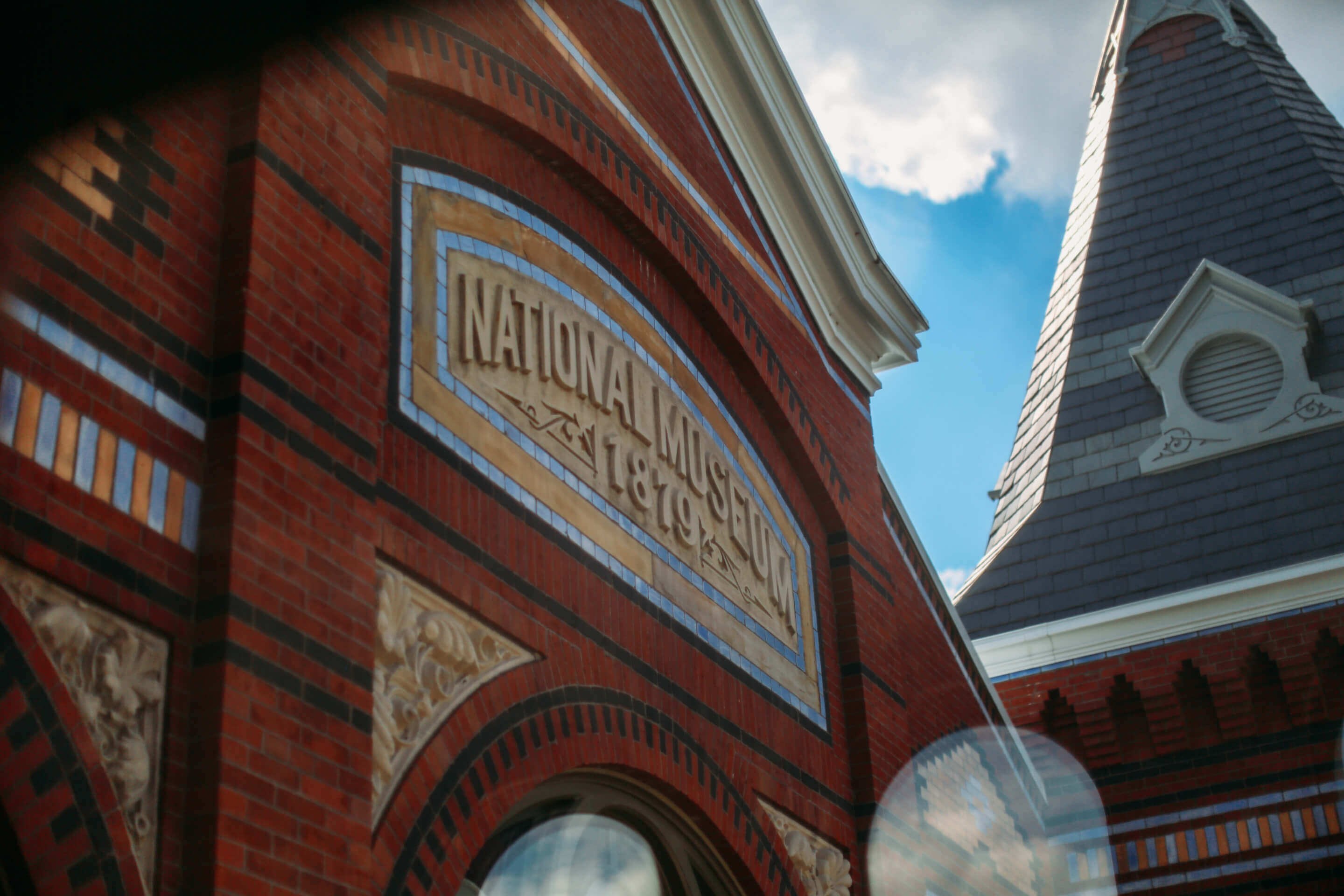
“Goethe said that limitations make the master, and I really feel like that was true,” added Goslins. “And I give Rockwell Group, almost all the credit for this. They came up with such creative solutions when, with almost everything we wanted to do, the first answer was ‘you can’t do that because this is a historical building.’”
Rockwell echoed the myriad challenges that came with launching a major exhibition within the AIB. “But what was easy was being inspired by the space,” he explained. “There was something about working in this building that had been stood the test of time since 1881 with so many visions about the future that had lived there.”
When FUTURES closes on July 6, 2022, the AIB will continue to host temporary exhibitions and events that, much like in its late-19th- and early 20th-century heyday, focus on visionary ideas and innovations. Following that will be a full-scale renovation although the timeline for that undertaking has not been established.
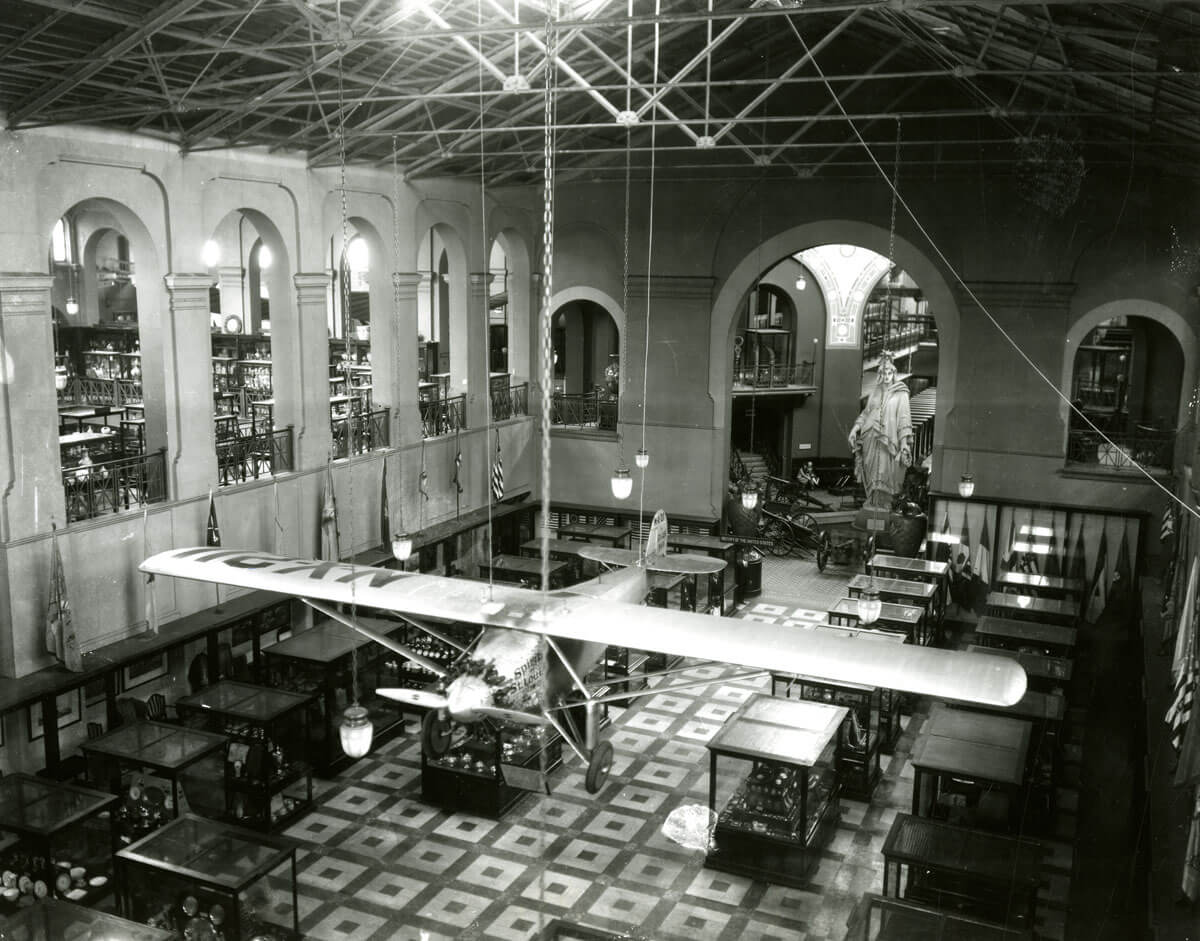
“The future of this building is a very current conversation, and there’s nothing like an empty building on the National Mall to invite a lot of opinions about what one should do with it,” explained Goslins. “We’re currently exploring several different kinds of content focuses for the building, and we’re absolutely committed to renovating it and reopening it for the public—whatever it is, that will be a multiyear process that involves federal and private funding.”
Kicking off this weekend and running through the end of this month is FUTURES Remixed, a multi-day fête celebrating the opening of the exhibition (and the temporary revival of the AIB) with a range of special programming including an indoor-outdoor concert featuring rapper and biologist Mariah the Scientist, DJ Bright Light Bright Light, and more. In addition to FUTURES Remixed, a range of public events will be held at the AIB throughout the run of the exhibition. FUTURES is free and open to the public every day of the week save Tuesdays.






